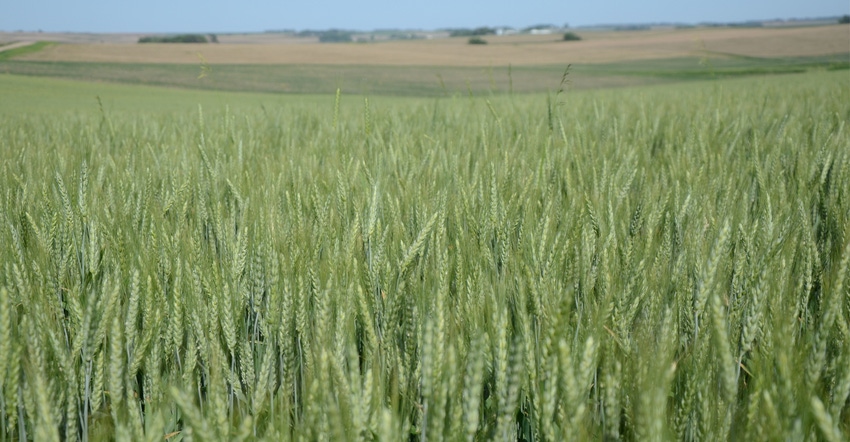
For many growers in western Nebraska, the dryland rotation is one of compromises, dominated by wheat-corn-fallow. This leaves residue to hold moisture and fight weed pressure, but it also leaves an entire year between corn harvest and winter wheat planting. That's why some growers in the southwest part of the state are turning their attention to spring wheat.
Strahinja Stepanovic, graduate student at the University of Nebraska-Lincoln, conducted a trial this year at the Stumpf Research Center in Grant to evaluate different spring wheat varieties, as well as different practices and their effect on yield.
This included 19 varieties, five nitrogen treatments and three tillage treatments. This included varieties from WestBred, AgriPro (Syngenta), Montana State University, South Dakota State University, and the Minnesota Crop Improvement Association.
While the plot averaged 16.8 bushels per acre, yields of different varieties ranged from 12 to 20.2 bushels per acre — about 42% of a neighboring winter wheat plot (47 bushels per acre) — although some individual plots reached as much as 30 bushels per acre.
"I'm speculating that the yield difference is going to be more than people think," Stepanovic says. "A lot of people think we can get within 60% of winter wheat yields, and I think that will be a real challenge. We've done genetic improvement on winter wheat in our area over the past 30 to 40 years. For spring wheat, the genetic improvement in this area is nonexistent — and it's hard to compare, because they fit in the rotation differently."
Optimum N rate
Nitrogen treatments ranged from a zero nitrogen control to 200 pounds per acre, with 50-pound increments in between. All applications were liquid urea ammonium nitrate (32-0-0).
"This year, given the moisture we had and yield, the optimal rate was 51 pounds per acre. It really starts to level out after that," Stepanovic says. "The response to nitrogen continues after 50 pounds, but it's in such small increments that it wouldn't pay off to go beyond that this year."
While the first 50 pounds added 10 bushels per acre, the next 150 pounds added 6 to 7 bushels.
The optimum nitrogen rate in a given rate depends on several factors: yield potential, grain price and the investment in nitrogen fertilizer. For example, Stepanovic found with a wheat price of $5 per bushel, and a fertilizer price of $0.50 per pound, the economic optimum rate for 2020 would be about 51 pounds per acre.
UNL has outlined economically optimum nitrogen rates for various wheat and fertilizer prices at cropwatch.unl.edu.
There also were three tillage treatments: no-till, conventional till and vertical till — and these treatments yielded some surprising results.
"At nitrogen levels below 70 pounds, you can see tillage releasing some of the mineralized nitrogen in the soil," Stepanovic says. "Especially at zero nitrogen, tillage treatments actually yielded higher than no-till, although no-till was generally better, which is expected in a dry year."
Going beyond yield
As part of the research, Stepanovic is working with the baking and milling industry to identify varieties that meet certain specifications for quality factors such as falling number and protein content.
"What kind of varieties and what kind of milling and baking qualities does the industry want?" he asks. "We're going to go back and hand-pick a few varieties that are higher yielding and try to learn from those varieties on all levels how certain traits affect baking and milling. It's another spectrum of the same research that has implications for marketing."
The 2020 season started out dry in southwest Nebraska, with abnormally dry conditions continuing into April; followed by average rainfall in May; a hot, dry June; and average rainfall in July. Although this wasn't an ideal year for spring wheat, Stepanovic encourages growers to keep trying.
"We don't know if this is going to be valuable until we have at least five years of experience," he says. "With wheat in a dryland rotation, you're often raising a crop for the residue. Even if you break even, that residue is the most valuable thing you can have."
Stepanovic adds growers should keep in mind that spring wheat typically produces about 30% less residue than winter wheat.
"There are growers who are already growing spring wheat. I think there is a future," Stepanovic adds. "You've got to start somewhere, the same as any alternative crop. We need more crops in the rotation, and that takes time and work. Developing varieties for this area can happen, but before that, there's going to have to be enough interest, enough marketing, and there's going to have to be enough will and funding. That may take 20 years, but we've got to think that way."
About the Author(s)
You May Also Like






